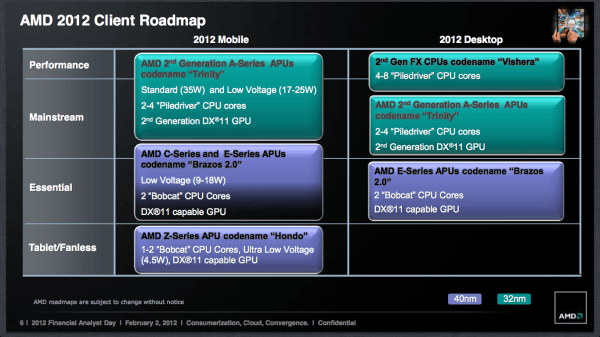AMD has confirmed that its next-generation accelerated processing units (APUs) under the A-Series "Trinity" and E/C-Series "Brazos 2.0" lines, have begun shipping to device manufacturers and should start showing up in consumer laptops and desktops this quarter. The chips represent the second wave of Fusion products from AMD, combining general processor execution and integrated discrete-level graphics in a single die.
The A-Series chips will be targeted at mainstream laptops and desktops. They will have TDPs between 17W and 35W and feature two or four "Piledriver" cores, which are enhanced variants of the Bulldozer core found on FX Series processors, as well as an AMD Radeon HD 7000-series "Southern Islands" graphics core with DirectX 11-class graphics support, and other improvements such as a new energy-recycling tech.

Trinity will reportedly will deliver a 25% performance improvement and 50% graphics improvement over the current A-series APUs, while doubling the performance-per-watt. AMD CEO Rory Read said during an earnings call Thursday that a record number of products based on Trinity and Brazos 2.0 are in the works.
The chips will go against Ivy Bridge and it looks like undercutting Intel on price will be part of AMD's strategy, with the firm reportedly pushing Trinity APUs into ultrathin laptops starting at $500.
AMD will also launch new C- and E-series processors, which were arguably the most succesful from the first round of Fusion chips, and are destined for low-cost, low-power netbooks, notebooks and nettops. These will have TDPs between 9W and 18W, two 40nm Bobcat CPU cores, a Radeon HD 7000-series GPU, and a single-channel DDR3 memory controller, as well as native USB 3.0 and SATA III through the accompanying chipset.